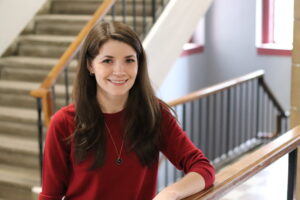
Alumna Sara Hanrahan discusses her career as a Teaching Associate Professor at the University of Tennessee Knoxville and how her time in the Biomedical Engineering program at the University of Utah helped to lead her down that path.
How did your Biomedical Engineering education and research at the University of Utah impact your vision for your career?
My time as a PhD student at the University of Utah was instrumental in shaping my interdisciplinary approach to biomedical engineering. The collaborations I developed with physicians, electrical engineers, and mechanical engineers in my program reinforced my belief that solving complex problems requires expertise from multiple fields. I continue to seek out interdisciplinary projects and form teams with expertise from diverse fields. In my current role as a professional educator, I am updating our undergraduate biomedical engineering curriculum, aiming to inspire the next generation of biomedical engineers to tackle the challenges of medicine, industry, and research through interdisciplinary approaches.
Plot your career development to your current point for me: Looking back, what were major determinants to put you where you are now?
I had two transformational experiences at Utah that profoundly shaped my career path. My first was conducting research with epilepsy patients alongside neurosurgeon Dr. Paul House. Working directly with patients provided invaluable insight into the entire workflow of surgery and patient care, deepening my appreciation for the clinical aspects of biomedical research. After graduating with my Ph.D., I became a clinical neurophysiologist and investigator scientist with another neurosurgeon, Dr. Adam Hebb, at Swedish Medical Center and later at St. Joseph’s Hospital in Denver, CO. In this role, I guided the implantation of deep brain stimulation electrodes for the treatment of Parkinson’s disease in hundreds of patients. Witnessing firsthand the tangible impact of medical device innovation on patients’ lives was an experience I will never forget.
After having my first child, I needed a more flexible schedule. Reflecting on my favorite course at Utah, Systems Neuroscience, taught by Dr. Gregory Clark, I realized the profound influence it had on the way I approached research. This reflection led me to pursue a career in teaching, and I am now a Teaching Associate Professor at the University of Tennessee. I love the continuous learning that comes with my role and the opportunity to help passionate and driven students reach their career goals. I aspire to equip students with the knowledge, skills, and confidence to tackle complex challenges in medicine.
What recommendations do you have for BME students regarding their coursework, research, presentations, or any other assets for their future employment?
I tell my students to get involved with their community and make bold choices. Being an active member of student organizations, volunteering for causes that are meaningful to you, and engaging with your professors can all have a lasting impact on your career.
What do you value in the best quality people who work for you?
I love working with curious people. It’s energizing to work with colleagues who consistently demonstrate initiative and are fully engaged, as they genuinely want to learn more.
What do you enjoy in your leisure time?
I love hiking with my husband, Jacob, and our three kids, Calvin, Lucy, and Felix. While I miss the big vistas of Utah, I’ve also come to appreciate the beauty of the Smokies in Tennessee.
What do the next 10 years of your career look like to you?
I recently assumed the role of Associate Department Head of Undergraduate Programs for the newly independent Department of Biomedical Engineering at the University of Tennessee, Knoxville (UTK). It’s an exciting time for UTK BME. We’ve welcomed a new department head this summer and are preparing to hire several tenure-track faculty next year. I look forward to shaping our undergraduate curriculum to meet the evolving demands of the medical field.